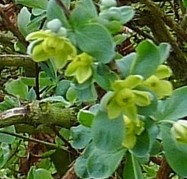 Found in Tibet in 1924, this barberry is relatively unknown. It has gracefully arching stems that are whitish gray at first, turning purple to shiny brown as they mature. The leaves are small oval and blue green with a bloom until fall when they turn bright orange to yellow. The pale yellow flowers appear singly in the spring and give way to small egg-shaped fruits that ripen in the fall to red and have a light bloom. Not as spiny as many other barberries, B. temolaica thrives in most soils including dry ones but does not tolerate poorly drained ones.
Found in Tibet in 1924, this barberry is relatively unknown. It has gracefully arching stems that are whitish gray at first, turning purple to shiny brown as they mature. The leaves are small oval and blue green with a bloom until fall when they turn bright orange to yellow. The pale yellow flowers appear singly in the spring and give way to small egg-shaped fruits that ripen in the fall to red and have a light bloom. Not as spiny as many other barberries, B. temolaica thrives in most soils including dry ones but does not tolerate poorly drained ones.
Type: Deciduous shrub
Outstanding Feature: Fall color; berries
Form: Loose, untidy look
Growth Rate: Slow
Bloom: Small, pale yellow flowers borne singly in spring
Size: 10’ H x 10’ W
Light: Sun to partial shade (best fruiting and fall color in full sun)
Soil: Average, well-drained
Hardiness: Zones 6-9
Care: Prune in winter only to maintain size and shape; rejuvenate by removing old stems and encouraging new growth.
Pests and Diseases: None of significance
Propagation: Seed, semi-ripe cuttings with heal in summer.
